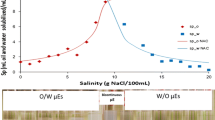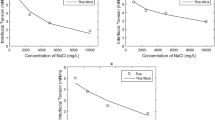Abstract
A quantitative structure property relationship approach was performed to find the relation between the surfactant structure and its effect on water–oil interfacial tension. As a result, a new database has been developed measuring the interfacial tension between n-decane as the model oil and different aqueous solutions of some ionic compounds. In spite of other reports we selected surfactants by a scientific method that covers all structural information. Twenty four different compounds were selected by the principle component analysis method and their interfacial tensions were measured at their critical micelle concentrations. The geometrical optimization of surfactants was performed at the B3LYP/6-311G** level and quantum chemical and structural descriptors were calculated using relevant computer software programs. The best fitted descriptors were selected using the variable selection of the genetic algorithm (GA-MLR). The predictive test was performed for an external prediction set of 6 compounds, chosen out of 24 compounds. The resulted GA-MLR model can reasonably predict the interfacial tension using only three selected descriptors. The deviation between predicted and measured values was found to be <7%.










Similar content being viewed by others

Abbreviations
- QSPR:
-
Quantitative structure property relationship
- PCA:
-
Principal component analysis
- GA:
-
Genetic algorithm
- MLR:
-
Multiple linear regression
- CMC:
-
Critical micelle concentration
- PC:
-
Principle component
- SVD:
-
Singular value decomposition
- DFT:
-
Density functional theory
- Jhetv:
-
Van der Waals’ weighted distance matrix
- RDF:
-
Radial distribution function
- ASDA:
-
Axisymmetric drop shape analysis
- ME:
-
Mean effect
- LMO:
-
Leave many out
References
Butt HJ, Graf KH, Kappl M (2006) Physics and chemistry of interfaces, 2nd edn. Wiley-VCH, Weinheim
Schramm LL (2000) Surfactants: fundamentals and applications in the petroleum industry. Cambridge University Press, Cambridge
Esumi K, Ueno M (2003) Structure-performance relationships in surfactants. Surfactant science series, vol 112, 2nd edn. Marcel Dekker, New York
Hu JW, Zhang XY, Wang ZW (2010) A review on progress in QSPR studies for surfactants. Int J Mol Sci 11:1020–1047
Goldberg DE (1989) Genetic algorithms in search, optimization, and machine learning. Addison-Wesley, Reading
Leardi R (2001) Genetic algorithms in chemometrics and chemistry: a review. J Chemom 15:559–569
Hastie T, Tibshirani R, Friedman JH (2009) The elements of statistical learning: data mining, inference, and prediction, 2nd edn. Springer, New York
Wang ZW, Feng JL, Wang HJ, Cui ZG, Li GZ (2005) Effectiveness of surface tension reduction by nonionic surfactants with quantitative structure-property relationship approach. J Dispers Sci Technol 26:441–447
Wang ZW, Li GZ, Mu JH, Zhang XY, Lou AJ (2002) Quantitative structure-property relationship on prediction of surface tension of nonionic surfactants. Chin Chem Lett 13:363–366
Kier LB, Hall LH (1999) Molecular structure description: the electrotopological state. Academic Press, San Diego
Wang ZW, Huang DY, Li GZ, Zhang XY, Liao LL (2003) Effectiveness of surface tension reduction by anionic surfactants, a quantitative structure-property relationship. J Dispers Sci Technol 24:653–658
Jolliffe IT (2002) Principal component analysis. Springer series in statistics, 2nd edn. Springer, New York
Brereton RG (2003) Chemometrics: data analysis for the laboratory and chemical plant. Wiley, New York
Golub GH, Van Loan CF (1996) Matrix computations. Johns Hopkins studies in the mathematical sciences, 3rd edn. Johns Hopkins University Press, Baltimore
HyperChem(TM) Professional Hypercube Inc., 1115 NW 4th Street Gainesville Florida 32601 USA
Todeschini R, Consonni V, Pavana M, Milano Chemometrics and QSAR Group. http://www.disat.unimib.it/chm/
Gaussian 98, Frisch MJ, Trucks GW, Schlegel HB, Scuseria GE, Robb MA, Cheeseman JR, Zakrzewski VG, Montgomery Jr. JA, Stratmann RE, Burant JC, Dapprich S, Millam NJ, Daniels AD, Kudin KN, Strain MC, Farkas O, Tomasi J, Barone V, Cossi M, Cammi R, Mennucci B, Pomelli C, Adamo C, Clifford S, Ochterski J, Petersson GA, Ayala PY, Cui Q, Morokuma K, Malick DK, Rabuck AD, Raghavachari K, Foresman JB, Cioslowski J, Ortiz JV, Stefanov BB, Liu G, Liashenko A, Piskorz P, Komaromi I, Gomperts R, Martin RL, Fox DJ, Keith T, Al-Laham MA, Peng CY, Nanayakkara A, Gonzalez C, Challacombe M, Gill PMW, Johnson B, Chen W, Wong MW, Andres JL, Gonzalez C, Head-Gordon M, Replogle ES, Pople JA (1998) Gaussian Inc., Pittsburgh PA
Carpena P, Aguiar J, Bernaola-Galvan P, Ruiz CC (2002) Problems associated with the treatment of conductivity-concentration data in surfactant solutions: simulations and experiments. Langmuir 18:6054–6058
del Rio OI, Neumann AW (1997) Axisymmetric drop shape analysis: computational methods for the measurement of interfacial properties from the shape and dimensions of pendant and sessile drops. J Colloid Interface Sci 196:136–147
Bouchot C, Richon D (2001) An enhanced method to calibrate vibrating tube densimeters. Fluid Phase Equilib 191:189–208
Goebel A, Lunkenheimer K (1997) Interfacial tension of the water/n-alkane interface. Langmuir 13:369–372
Zeppieri S, Rodriguez J, de Ramos ALL (2001) Interfacial tension of alkane plus water systems. J Chem Eng Data 46:1086–1088
Linstrom PJ, Mallard WG (eds) (2010) NIST Chemistry WebBook, NIST standard reference database number 69, National Institute of Standards and Technology. Gaithersburg MD, 20899, http://webbook.nist.gov
Todeschini R, Consonni V (2000) Handbook of molecular descriptors. Methods and principles in medicinal chemistry. Wiley-VCH, Weinheim
Balaban AT (1982) Highly discriminating distance-based topological index. Chem Phys Lett 89:399–404
Gu T, Sjöblom J (1992) Surfactant structure and its relation to the Krafft point, cloud point and micellization: some empirical relationships. Colloids Surf 64:39–46
Author information
Authors and Affiliations
Corresponding author
About this article
Cite this article
Fallah Fini, M., Riahi, S. & Bahramian, A. Experimental and QSPR Studies on the Effect of Ionic Surfactants on n-Decane–Water Interfacial Tension. J Surfact Deterg 15, 477–484 (2012). https://doi.org/10.1007/s11743-012-1330-7
Received:
Accepted:
Published:
Issue Date:
DOI: https://doi.org/10.1007/s11743-012-1330-7



